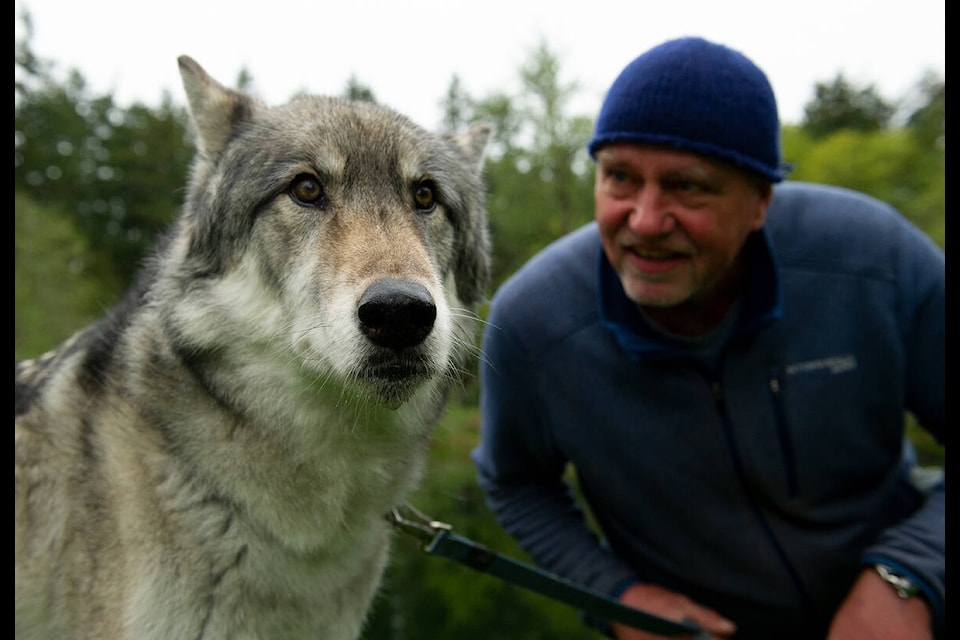As human development continues to encroach on nature, encounters with wildlife are becoming more and more common. With these changing relationships, new consequences, problems and possibilities are emerging. The philosophical and ethical questions that arise as we find ourselves face-to-face with wildlife in our own backyards are explored in Part of the Pack, a feature-length documentary about the relationship between humans and wolves on Vancouver Island.
The film follows three animal lovers who are seeking connection with wolves in various ways on Vancouver Island. There’s Gary Allan, a self-described “wolf educator” who tours schools with his wolf Tundra, and who keeps multiple wolves on his property in Nanaimo, B.C. Cheryl Alexander is a conservation photographer who achieved international fame for her photos of a lone wolf named Takaya who lived on a small island off Victoria. And the third of the film’s subjects is Samantha Law, a woman living in Vancouver who finds comfort and meaning after a traumatic period in her life, from her relationship with her wolf-dog Luna.
Co-directors Isabelle Groc and Mike McKinlay do a fantastic job of exploring the complex topic. There are many complicated perspectives in the film, including the voices of pet owners, wildlife specialists, lawyers and more, each speaking to the nuances of co-existing with wildlife, and what degree of interaction is healthy for both human and animal.
For example, Samantha Law is a woman whose love and fascination with her wolf-dog, Luna, is evident. She expresses a desire to give her pet the best life possible, and there are some beautiful, intimate moments shown on camera between the two, but Law also speaks to the growing burden of trying to domesticate an animal that is wild at heart. It becomes increasingly clear how different Luna is from a regular dog: Luna puts a rotting turkey in the couch at one point. Wrestling with conflicting and difficult feelings while raising Luna, Law eventually comes to her own conclusion on what is moral and whether or not wolf-dogs should be pets.
McKinlay and Groc’s intention is that the viewer is left ultimately to do some analysis themselves, rather than being persuaded to a specific point of view.
“As documentary filmmakers, our goal is always to take an objective stance in a film such as this,” said McKinlay. “I would say that I instead would love the viewer to walk away from the film asking themselves where THEY land in regard to their feelings around connecting to nature. What does it mean to them to ‘connect’, and how would they go about doing so? To really reflect on how we as a society (for which, in many ways, are disconnected to nature) can re-connect in a manner that serves both humanity and the wild.”
Apart from the dynamic storytelling (which has some surprising story arcs that even the directors could not have foretold), the cinematography done by Mike McKinlay is beautiful and there are some incredible shots of wolves, both wild and domesticated, on Vancouver Island. The imagery emphasizes the enchantment and romanticism that wolves can stir up, blurring the lines between what’s perceived and what’s real. This enchantment is embodied by Cheryl Alexander, the wildlife photographer whose muse was the wild wolf, Takaya.
“I felt sometimes when I would arrive, he would howl and I thought he was howling to me like there was something communicative,” she says in the film. The captivating imagery along with Alexander’s sentiment is juxtaposed with a reminder from wildlife co-existence specialist Bob Hansen that wolves are not benign. “It’s a wild predator,” Hansen cautions in the film. And as people who have followed Takaya’s story on the news know (he eventually died at the hands of a hunter), his death has stirred controversy on the consequences of becoming too close to wild wolves and hunting laws in B.C.
The film also provides a lot of interesting factual and contextual information, especially for viewers on Vancouver Island. Viewers might learn, as I did, that wolf hunting is permitted in B.C. or that there is a law against owning a wolf as a pet, but that wolf-dog hybrids can be legally possessed with special permits.
There are lots of eye-openers in this film, as McKinlay can attest to.
“I learned while shooting in the wild just how much space wolves truly need to exist in our world,” McKinlay said. “We spent time filming the infamous sea wolves of Vancouver Island, and it was incredible to learn (from our expedition leader specifically) just how far wolves travel for territorial reasons even throughout one single day. This gave me a serious reality check as to how important it is for us to preserve habitat for these animals. Not just a little bit of habitat, but a lot. They need room to move and they need intact habitat to live successfully.”
Part of the Pack has garnered a lot of critical acclaim for being an intelligent and moving film on a timely topic. It has won two awards and is also nominated for 5 Leo Awards: Best Feature Length Documentary Program; Best Direction; Best Screenplay; Best Cinematography; and Best Musical Score (the awards will be announced on July 8 and 9).
To see Part of the Pack, tune in to the world broadcast premiere on Knowledge Network, B.C.’s public broadcaster, on Tuesday, June 6 at 9 p.m. The film will also be available to stream across Canada at knowledge.ca.
